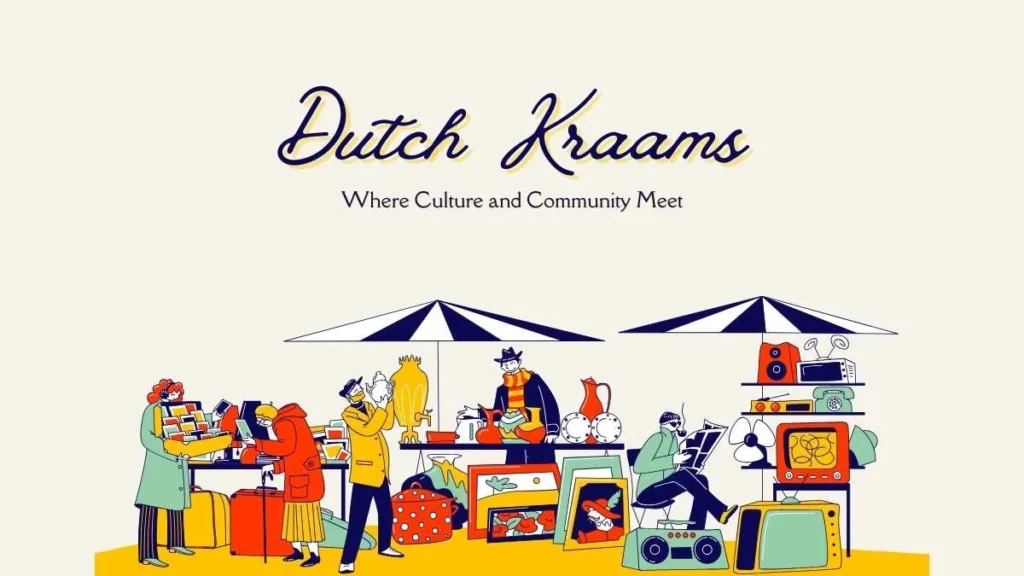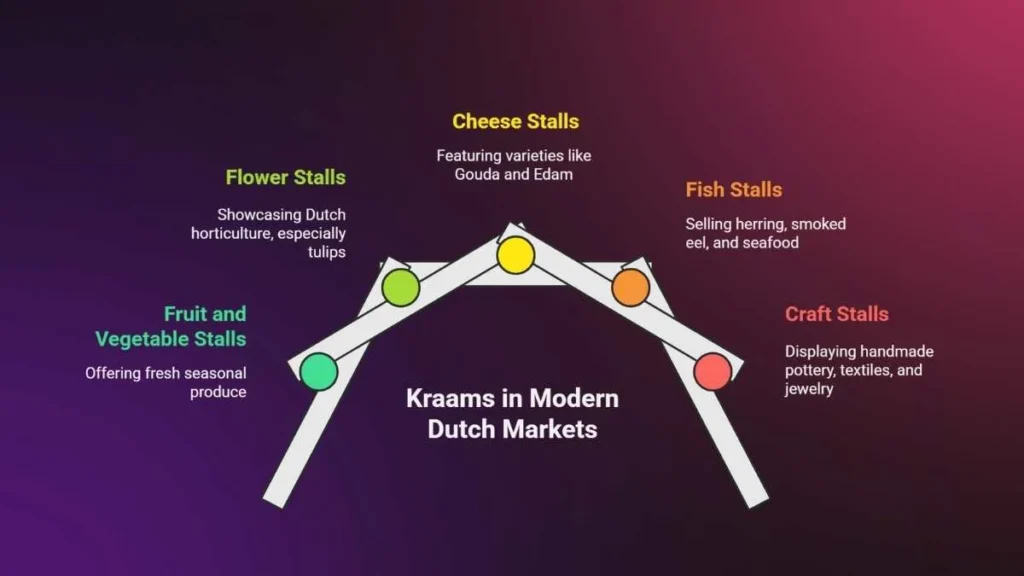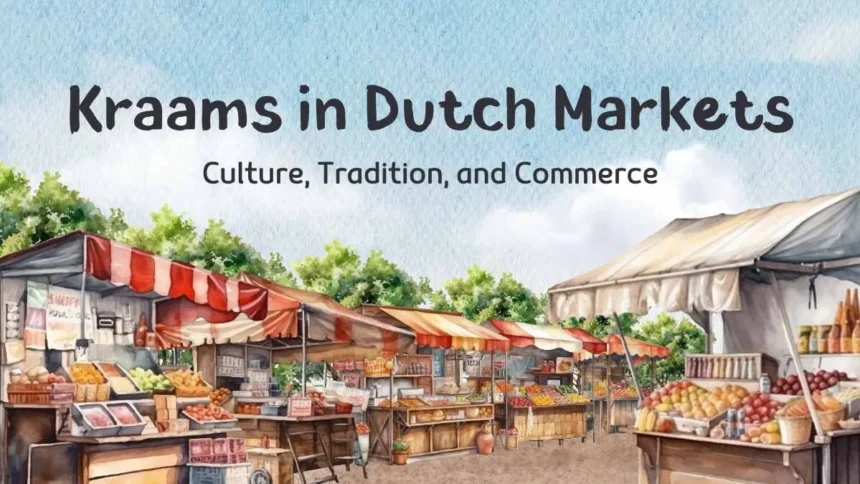Kraams in Dutch culture refer to the small yet vital market stalls that shape the identity of local street markets and fairs. A kraam is more than a temporary booth; it is a stand where vendors sell goods like fruits, vegetables, flowers, cheese, fish, or handmade crafts. These stalls create the backbone of marketplaces in the Netherlands, connecting producers directly with consumers.
What makes it unique is how they blend commerce, culture, and community. From medieval towns to modern cities, kraams have remained a central part of Dutch life. They are not just selling points; they symbolize tradition, local identity, and social interaction. This article examines their origins, cultural significance, modern evolution, and the reasons why they continue to draw both locals and tourists.
What Does “Kraam” Mean in Dutch?
The Dutch word “kraam” is commonly used to describe a market stall, a booth, or a stand where vendors display and sell their goods. These structures are often temporary, set up in open-air markets, weekly gatherings, or seasonal fairs. They may be simple wooden stands covered with fabric or modern modular setups with canopies and branding.

While the physical form of kraams may vary, the essence remains the same: they are spaces where commerce meets community. For centuries, they have served as a link between producers and consumers, reflecting both tradition and innovation in Dutch market culture.
Historical Development
The tradition of kraams dates back centuries:
- Medieval Era: Town squares were filled with stalls offering daily essentials such as grains, dairy, and fabrics.
- Golden Age (17th Century): Dutch global trade brought exotic goods like spices and cocoa, enriching local markets.
- Industrialization (19th Century): While factories rose, kraams continued to deliver farm produce and crafts, blending old with new.
Why Kraams Are Important
It carries multiple layers of significance within Dutch society. They connect communities by creating shared spaces where locals gather, support sustainability by promoting seasonal and locally produced goods, and preserve tradition by keeping centuries-old market culture alive. At the same time, they showcase Dutch identity through iconic products such as flowers, cheese, and maritime produce. In short, kraams symbolize the very soul of Dutch street markets.
Types of Kraams and Their Offerings
| Type of Kraam | Common Goods Sold | Cultural Significance |
| Fruit & Vegetable | Apples, potatoes, cabbage, carrots | Promotes seasonal, local farming |
| Flower | Tulips, bulbs, bouquets | Represents Dutch horticultural pride |
| Cheese | Gouda, Edam, specialty varieties | Reflects dairy traditions |
| Fish | Herring, smoked eel, shellfish | Connects to maritime heritage |
| Craft & Textile | Jewelry, pottery, fabrics | Preserves artisanal heritage |
| Global Food Stalls | Spices, roti, satay, street snacks | Reflects multicultural influence |
Famous Markets Known for Kraams
To truly understand the role of kraams, it helps to look at some iconic Dutch markets:
Albert Cuyp Market (Amsterdam)
This bustling market features hundreds of kraams selling food, fabrics, electronics, and international goods. It’s one of the most famous examples of how kraams adapt to both local and global trends.
Bloemenmarkt (Amsterdam)
The world’s only floating flower market, where kraams sell tulips, bulbs, and plants, blending tradition with tourism.
Markt in Delft
Located in the town square, it specializes in fresh produce and crafts, set against a historic backdrop.
Rotterdam’s Multicultural Markets
These markets highlight the diversity of modern Dutch society, with kraams offering Middle Eastern spices, Asian delicacies, and African crafts.
Leiden Saturday Market
Kraams line the canals, creating a picturesque shopping experience that combines history, scenery, and local flavor.
Serving as Tourist Attractions
For visitors, it’s more than shopping points; they’re experiences. Tourists enjoy:
- Sampling stroopwafels from sweet stalls.
- Buying tulip bulbs as souvenirs.
- Photographing the lively, colorful stalls.
- Tasting cheese varieties directly from local sellers.
Kraams provide an authentic taste of Dutch life that no shopping mall can replicate.
Role in Modern Dutch Markets
Today, it remains the highlight of street markets. They are often found in city centers, alongside canals, or in festive squares. Common types include:
- Fruit and vegetable stalls with fresh seasonal produce.
- Flower stalls, especially tulips, showcase Dutch horticulture.
- Cheese stalls offering varieties like Gouda and Edam.
- Fish stalls selling herring, smoked eel, and seafood.
- Craft stalls displaying handmade pottery, textiles, and jewelry.

Working as Spaces of Cultural Exchange
Dutch Kraams are also places of multicultural interaction. With the Netherlands’ diverse population, it’s common to see stalls offering Turkish bread, Surinamese roti, Moroccan spices, or Indonesian satay.
This cultural exchange enriches the Dutch market tradition, turning kraams into symbols of global connection within local communities.
FAQs
Q1: Are kraams only found in large cities?
No, it is present in both big cities and small towns across the Netherlands.
Q2: Can it operate year-round?
Yes, many run weekly throughout the year, while others appear seasonally.
Q3: Do vendors need special permits to set up kraams?
Yes, municipalities usually require permits for operating stalls in public markets.
Conclusion
Kraams are not just market stalls, they are living traditions that continue to define Dutch culture. For centuries, they have offered fresh produce, flowers, cheese, and crafts while building bridges between people. Today, they thrive in modern markets by blending heritage with innovation.
Whether you are a local shopping for groceries or a tourist wandering through Dutch streets, a kraam represents more than commerce. It represents community, sustainability, and identity, values that remain timeless in the Netherlands.






